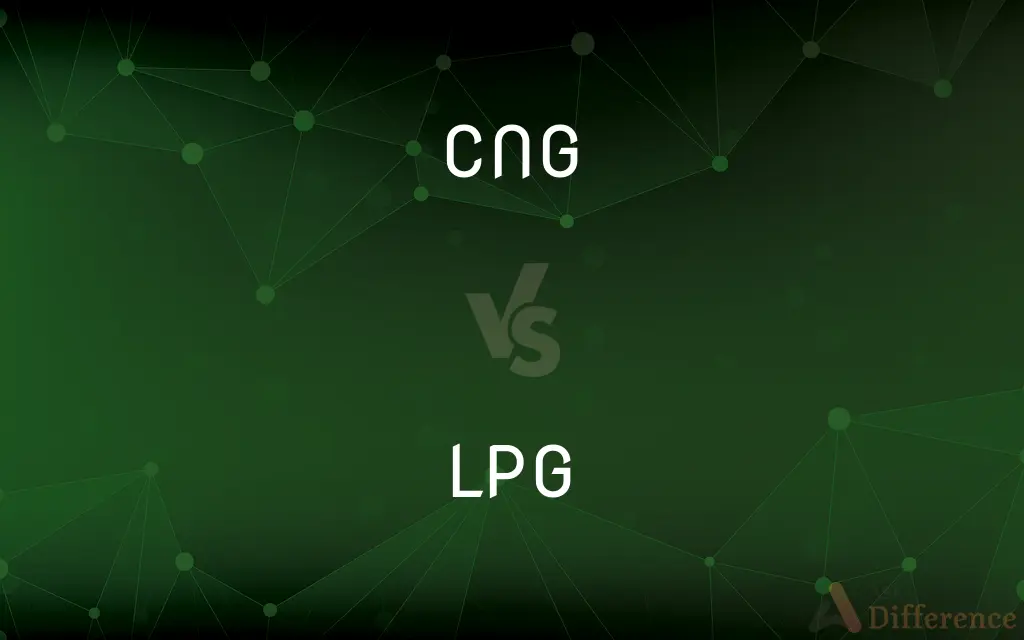CNG vs. LPG — What's the Difference?
By Tayyaba Rehman — Published on December 23, 2023
CNG is compressed natural gas, primarily methane, used as fuel; LPG is liquefied petroleum gas, a mix of propane and butane, also a fuel source.

Difference Between CNG and LPG
Table of Contents
ADVERTISEMENT
Key Differences
CNG, or Compressed Natural Gas, is primarily methane compressed to less than 1% of its volume at standard atmospheric pressure. LPG, or Liquefied Petroleum Gas, is a mixture of propane and butane liquefied through pressurization. Both are used as alternative fuels but have different physical states and applications.
CNG is stored and transported at high pressure, typically 200–250 bar. LPG, however, is stored as a liquid under moderate pressure or at low temperatures. CNG, being lighter than air, dissipates quickly when leaked, while LPG, heavier than air, poses a risk of pooling at ground level.
In terms of energy content, CNG has a lower energy density compared to LPG. This often translates to a lesser range for vehicles running on CNG than those using LPG. CNG is mainly methane and burns cleaner than LPG, emitting less carbon dioxide and pollutants.
CNG is often used in light passenger vehicles and public transport, while LPG finds applications in heating, cooking, and in some vehicles. The infrastructure for CNG is more complex due to its high-pressure requirements, while LPG can be transported and stored more easily.
Though both are considered cleaner alternatives to gasoline and diesel, their production and usage have environmental impacts. CNG, being a form of natural gas, is subject to methane leakage during extraction and transportation. LPG, derived from fossil fuels, also contributes to greenhouse gas emissions.
ADVERTISEMENT
Comparison Chart
Composition
Primarily methane.
Mixture of propane and butane.
Physical State
Stored and transported as a compressed gas.
Stored and transported as a liquefied gas.
Energy Density
Lower energy density compared to LPG.
Higher energy density than CNG.
Safety
Lighter than air, disperses quickly when leaked.
Heavier than air, can pool at ground level if leaked.
Common Applications
Used in vehicles and public transport.
Used in heating, cooking, and also in vehicles.
Compare with Definitions
CNG
CNG is considered more environmentally friendly than traditional fuels.
Using CNG helps reduce carbon emissions.
LPG
LPG is stored and transported in liquid form.
LPG cylinders contain the gas in a liquefied state.
CNG
CNG is natural gas compressed for storage and transport.
CNG stations store the gas at high pressure.
LPG
LPG is also used as a fuel for vehicles.
Her car is fitted with an LPG conversion kit.
CNG
CNG is primarily composed of methane.
CNG, being mostly methane, burns cleaner than other fuels.
LPG
LPG is used for heating in residential and commercial settings.
The central heating system is powered by LPG.
CNG
CNG serves as an energy source for vehicles and industries.
Many taxis have converted to CNG for efficiency.
LPG
LPG consists of propane and butane.
LPG's components make it versatile for different uses.
CNG
CNG is used as a cleaner alternative to gasoline in vehicles.
The city buses run on CNG to reduce pollution.
LPG
LPG is commonly used for cooking in homes and restaurants.
Our kitchen stove runs on LPG.
Common Curiosities
What is LPG?
LPG stands for Liquefied Petroleum Gas, used for cooking, heating, and as vehicle fuel.
What is CNG?
CNG stands for Compressed Natural Gas, primarily used as fuel in vehicles.
What are the uses of CNG?
CNG is used as fuel in vehicles and for industrial applications.
What is the main component of CNG?
CNG is primarily composed of methane.
How is CNG stored?
CNG is stored at high pressure as a compressed gas.
Is LPG a clean energy source?
LPG burns cleaner than some fuels, but it is derived from fossil fuels and contributes to greenhouse gas emissions.
What are the components of LPG?
LPG is a mixture of propane and butane.
How is LPG stored?
LPG is stored as a liquid under moderate pressure.
Is CNG environmentally friendly?
CNG is considered cleaner than traditional fuels, but its production and usage have environmental impacts.
Can CNG be used for cooking?
While possible, CNG is more commonly used for transportation and industrial purposes.
How are CNG and LPG supplied to consumers?
CNG is supplied through stations and pipelines, while LPG is often provided in cylinders.
Can LPG be used in vehicles?
Yes, LPG is used as fuel in some vehicles, often requiring a conversion kit.
What are the common uses of LPG?
LPG is used for cooking, heating, and in vehicles.
Is CNG safer than LPG?
CNG is lighter than air and disperses quickly, reducing certain risks, but both gases require careful handling.
Are CNG and LPG renewable energy sources?
No, both CNG and LPG are derived from fossil fuels and are not considered renewable.
Share Your Discovery

Previous Comparison
Short Run Production Function vs. Long Run Production Function
Next Comparison
Skimmed Milk vs. Toned MilkAuthor Spotlight
Written by
Tayyaba RehmanTayyaba Rehman is a distinguished writer, currently serving as a primary contributor to askdifference.com. As a researcher in semantics and etymology, Tayyaba's passion for the complexity of languages and their distinctions has found a perfect home on the platform. Tayyaba delves into the intricacies of language, distinguishing between commonly confused words and phrases, thereby providing clarity for readers worldwide.














































